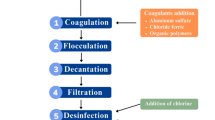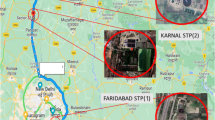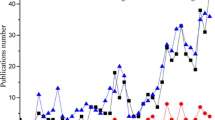Abstract
Water treatment is a vital process to ensure the development and sustainability of today’s society, both from an environmental and public health point of view. Wastewater treatment has a huge variety of studies and operations. In these processes, which are usually carried out in wastewater treatment plants (WWTPs), large quantities of toxic and highly heterogeneous sludge are generated, the proper management of which is a major challenge.
The overexploitation of limited natural resources and the enormous consumption of energy by modern society mean that substantial changes are needed in water and sludge treatment and purification systems. In this sense, it has been estimated that in Europe the generation of sludge in WWTPs will exceed 13 million tons/year in 2021. The detection of new contaminants in sewage sludge, as well as the significant increase in its production and its limited usefulness in agricultural applications, makes it necessary to invest in research and development of technological solutions that respond to the demanding restrictions established by the European legislation.
To aid in the knowledge on the presence and concentration of organic chemicals in sewage sludge, peer-reviewed literature and official government reports have been examined in this chapter.
Access this chapter
Tax calculation will be finalised at checkout
Purchases are for personal use only
Similar content being viewed by others
Abbreviations
- EPA:
-
United States Environmental Protection Agency
- ISS:
-
Industrial sewage sludge
- OPs:
-
Organophosphate pesticides
- PAH:
-
Polycyclic aromatic hydrocarbons
- PBB:
-
Polybrominated biphenyls
- PBDE:
-
Polybrominated diphenyl ethers
- PCB:
-
Polychlorinated biphenyls
- PCDDs:
-
Polychlorinated dibenzo-p-dioxins
- PCDFs:
-
Polychlorinated dibenzo-p-furans
- PFC:
-
Perfluorinated aliphatic compounds
- SS:
-
Sewage sludge
- TCDD:
-
Tetrachlorodibenzo-p-dioxin
References
Loizia P, Neofytou N, Zorpas AA (2019) The concept of circular economy strategy in food waste management for the optimization of energy production through anaerobic digestion. Environ Sci Pollut Res 26:14766–14773. https://doi.org/10.1007/s11356-018-3519-4
Turovskiy IS, Mathai PK (2005) Sludge quantities and characteristics. In: Wastewater sludge processing. Wiley, pp 30–59
Canziani R, Spinosa L (2019) Industrial and municipal sludge: emerging concerns and scope for resource recovery. In: Sludge from wastewater treatment plants. Elsevier
Tang K et al (2020) Removal of pharmaceuticals, toxicity and natural fluorescence by ozonation in biologically pre-treated municipal wastewater, in comparison to subsequent polishing biofilm reactors. Water 12:1059–1074. https://doi.org/10.3390/w12041059
Metcalf and Eddy (2014) Wastewater engineering treatment and resource recovery.5th edn. McGrawHill
Andreoli CV, von Sperling M, Fernandes F (2007) Chapter 2. Sludge characteristics and production. In: Sludge treatment and disposal. IWA Publishing, London, pp 18–44
European Commision (2012) Glossary of terms related to urban waste water. https://ec.europa.eu/environment/water/water-urbanwaste/info/glossary_en.htm. Accessed 20 Jan 2021
Kacprzak M et al (2017) Sewage sludge disposal strategies for sustainable development. Environ Res 156:39–46
European Commission (2001) European Commission DG Environment–B/2. Disposal and recycling routes for sewage sludge – part 3: scientific and technical sub-component report
Werther J, Ogada T (1999) Sewage sludge combustion. Prog Energy Combust Sci 25(1):55–116
Johnson OA, Affam AC (2019) Petroleum sludge treatment and disposal: a review. Environ Eng Res 24(2):191–201
Ali AM, Abu-Hassan MA, Ibrahim RRK, Zaini MAA, Abdulkarim BI, Hussein AS, Su SM, Mohd Halim MAI (2017) Characterization of petroleum sludge from refinery industry biological wastewater treatment unit. Preprints 2017:2017080033. https://doi.org/10.20944/preprints201708.0033.v1
Islam B (2015) Petroleum sludge, its treatment and disposal. A review. Int J Chem Sci 13(4):1584–1602
Gadipelly C et al (2014) Pharmaceutical industry wastewater: review of the technologies for water treatment and reuse. Ind Eng Chem Res 53(29):11571–11592
Iqbal SA, Mahmud I, Quader AK (2014) Textile sludge management by incineration technique. Procedia Eng 90:686–691. https://doi.org/10.1016/j.proeng.2014.11.795
Mani S, Bharagava RN (2018) 3 Textile industry wastewater environmental and health hazards and treatment approaches. CRC Press
Lotito AM, de Sanctis M, Di Iaconi C, Bergna G (2014) Textile wastewater treatment: aerobic granular sludge vs activated sludge systems. Water Res 54:337–346. https://doi.org/10.1016/j.watres.2014.01.055
Simão L et al (2018) Wastes from pulp and paper mills – a review of generation and recycling alternatives. Cerâmica 64(371):443–453
de Azevedo ARG et al (2019) Characterizing the paper industry sludge for environmentally-safe disposal. Waste Manag 95:43–52. https://doi.org/10.1016/j.wasman.2019.06.001
Morales AB et al (2016) Agri-food sludge management using different co-composting strategies: study of the added value of the composts obtained. J Clean Prod 121:186–197
Pascual JA et al (2018) Characterisation of sludge produced by the agri-food industry and recycling options for its agricultural uses in a typical Mediterranean area, the Segura River basin (Spain). Waste Manag 82:118–128. https://doi.org/10.1016/j.wasman.2018.10.020
Seviour R, Nielsen PH (2010) Microbial ecology of activated sludge.1st edn. IWA Publishing, London
Hatamoto M et al (2017) Microbial community structure and enumeration of bacillus species in activated sludge. J Water Environ Technol 15(6):233–240
Hu M, Wang X, Wen X, Xia Y (2012) Microbial community structures in different wastewater treatment plants as revealed by 454-pyrosequencing analysis. Bioresour Technol 117:72–79. https://doi.org/10.1016/j.biortech.2012.04.061
Nascimento AL et al (2018) Sewage sludge microbial structures and relations to their sources, treatments, and chemical attributes. Front Microbiol 9:1–11
Ibarbalz FM, Figuerola ELM, Erijman L (2013) Industrial activated sludge exhibit unique bacterial community composition at high taxonomic ranks. Water Res 47(11):3854–3864. https://doi.org/10.1016/j.watres.2013.04.010
Meerbergen K et al (2017) Assessing the composition of microbial communities in textile wastewater treatment plants in comparison with municipal wastewater treatment plants. MicrobiologyOpen 6(1):1–13
Rosińska A (2019) Traditional contaminants in sludge. In: Industrial and municipal sludge: emerging concerns and scope for resource recovery. Elsevier, pp 425–453
I C Consultants Ltd London, Technical University Munich, IRSA Rome, ECA Barcelona (2001) Pollutants in urban waste water and sewage sludge. European Commission. http://scholar.google.com/scholar?hl=en&btnG=Search&q=intitle:Pollutants+in+urban+waste+water+and+sewage+sludge#0
EPA (2020b) Polychlorinated biphenyls (PCBs). https://www.epa.gov/pcbs/learn-about-polychlorinated-biphenyls-pcbs#:~:text=PCBs have been demonstrated to system and other health effects. Accessed 6 Nov 2020
EPA (2017) Technical fact sheet – polybrominated biphenyls (PBBs). pp 1–5
Javier F, Zavala-Díaz de la Serna FJ (2015) Revisión Global de Los Contaminantes Emergentes PBDE y El Caso Particular de México. Rev Int Contam Ambient 31(3):311–320
Öberg K, Warman K, Öberg T (2002) Distribution and levels of brominated flame. Chemosphere 48:805–809
EPA (2020a) Basic information of PFAS. https://www.epa.gov/pfas/basic-information-pfas#health. Accessed 23 Nov 2020
Gómez-Canela C, Barth JA, Lacorte S (2012) Occurrence and fate of perfluorinated compounds in sewage sludge from Spain and Germany. Environ Sci Pollut Res 19(9):4109–4119
Sidhu GK et al (2019) Toxicity, monitoring and biodegradation of organophosphate pesticides: a review. Crit Rev Env Sci Tec 49(13):1135–1187. https://doi.org/10.1080/10643389.2019.1565554
Hernández-Abreu AB et al (2021) Effective adsorption of the endocrine disruptor compound bisphenol a from water on surface-modified carbon materials. Appl Surf Sci 552:149513
Enyoh CE et al (2020) Microplastics exposure routes and toxicity studies to ecosystems : an overview. Environ Anal Health Toxicol 35(1):1–10
Zhang Z, Chen Y (2020) Effects of microplastics on wastewater and sewage sludge treatment and their removal : a review. Chem Eng J 382:122955. https://doi.org/10.1016/j.cej.2019.122955
Rolsky C, Kelkar V, Driver E, Halden RU (2020) Municipal sewage sludge as a source of microplastics in the environment. Environ Sci Health 14:16–22. https://doi.org/10.1016/j.coesh.2019.12.001
Reyes-Contreras C et al (2020) Organic micropollutants in sewage sludge: influence of thermal and ultrasound hydrolysis processes prior to anaerobic stabilization. Environ Technol 41(11):1358–1365. https://doi.org/10.1080/09593330.2018.1534892
Taboada-Santos A et al (2019) Thermal hydrolysis of sewage sludge partially removes organic micropollutants but does not enhance their anaerobic biotransformation. Sci Total Environ 690:534–542. https://doi.org/10.1016/j.scitotenv.2019.06.492
USEPA (2020) CFR 40, 2020. https://www.govinfo.gov/content/pkg/CFR-2020-title40-vol31/pdf/CFR-2020-title40-vol31.pdf. Accessed 5 Jul 2021
Harrison EZ, Oakes SR, Hysell M, Hay A (2006) Organic chemicals in sewage sludges. Sci Total Environ 367(2–3):481–497
Wild SR, Jones KC (1991) Organic contaminants in wastewaters and sewage sludges: transfer to the environment following disposal. Environ Manag Ser (EMISS) 19:133–158
Acknowledgments
This work has been supported by the Comunidad de Madrid (Spain) through the Industrial PhD projects (IND2017/AMB-7720 and IND2019/AMB-17114), REMTAVARES Network (S2018/EMT-4341) and the European Social Fund. In addition, the authors thank the financial support from the Spanish MICINN through the project CATAD3.0 PID2020-116478RB-I00.
Author information
Authors and Affiliations
Corresponding author
Editor information
Editors and Affiliations
Rights and permissions
Copyright information
© 2022 The Author(s), under exclusive license to Springer Nature Switzerland AG
About this chapter
Cite this chapter
Jiménez, J.C., Rodríguez, J.G., Mendioroz, B.H., Ismael Águeda Maté, V., Álvarez-Torrellas, S. (2022). Revision of the Most Harmful Organic Compounds Present in Sewage and Sludge. In: Núñez-Delgado, A., Arias-Estévez, M. (eds) Emerging Pollutants in Sewage Sludge and Soils. The Handbook of Environmental Chemistry, vol 114. Springer, Cham. https://doi.org/10.1007/698_2022_855
Download citation
DOI: https://doi.org/10.1007/698_2022_855
Published:
Publisher Name: Springer, Cham
Print ISBN: 978-3-031-07608-4
Online ISBN: 978-3-031-07609-1
eBook Packages: Chemistry and Materials ScienceChemistry and Material Science (R0)




